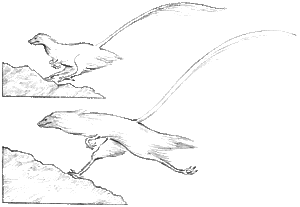
When not hunting the male mountain leapers stand as motionless sentinels, guarding the females and the young of the pack. On bright days the pack may sun itself on the open slopes, at which time it is vulnerable to attack by birds of prey and mountain pterodactyl pterosaurs.
A Mountain Leaper, Montanus saltus, an agile, mountain-dwelling maniraptoran, closely related to the northclaw, from the tundra and alpine of northwestern and Western North America, in The New Dinosaurs: An Alternative Evolution. South American relatives include the cutlasstooth and dip.
The intelligence that gradually developed among the basal non-avian coelurosaurs enabled them to adapt to all kinds of harsh conditions. The large brain of the mountain leaper coordinates its movements, and enables it to make swift judgments as it springs and leaps between the spires and crags of the mountain peaks, hunting the small birds and small mountain placental mammals on which it feeds. It has developed a high degree of endothermy (warm-bloodedness) to help it to cope with the icy climates, and the thick shiny feathers are indicative of this, providing the insulation that keeps the animal's body at a constant temperature. The head and body reach a length of about 1 meter (3 feet), but the flowing hair-like feathers, the long legs and long balancing tail with its spectacular plume make it look much larger. Mountain leapers live in small packs, with the males undertaking all the hunting, and protection of the females and the young.

Mountain leapers are agile and swift when traversing the mountain peaks and crags. With surefooted springs and leaps they move rapidly, maintaining balance with the long tail.
